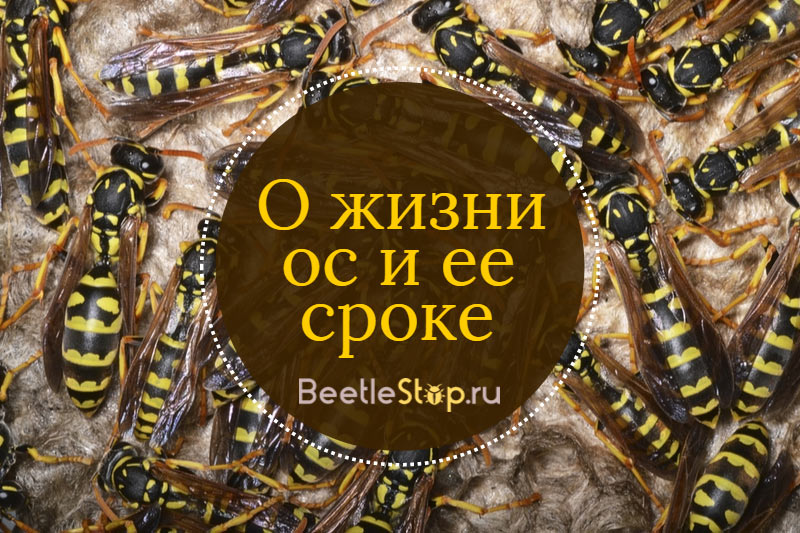How many wasps live - insect family hierarchy
In the world there are a huge number of species of wasps, which differ in lifestyle, behavior and appearance. They can be divided into two groups that determine the main features - social and solitary wasps. These insects have become a familiar environment in the warm season. They are annoying, often aggressive, so people such a neighborhood is unpleasant. How many wasps live depends on their position in the family hierarchy. Working individuals die quickly, and the life of the queens is longer.

Features of the appearance of insects
A distinctive feature of wasps is alternating yellow and black stripes on the body. They have a pair of webbed wings, antennae, which are sensory organs, and strong jaws, used to break prey. The sizes of insects vary significantly depending on the species, the body of digging wasps 5–20 mm long, and the chines 10–100 mm long.
Information. Wasps belong to the suborder Stem-bellied, the so-called insects having a thin waist - the anatomical segment connecting the chest and abdomen.
Bright coloring of adults warns of the presence of poison. Only females can sting the enemy. The sting is a modified ovipositor, so the males do not have it. Adult individuals (adults) eat plant foods, they prefer soft fruits and berries - raspberries, peaches, plums, grapes. They eat nectar and sweet syrup with pleasure. The need for proteins is satisfied by licking hemolymph - the blood of the victims. Larvae are carnivorous, they are fed with parts of the bodies of caterpillars, spiders, beetles, cicadas.
What determines the life span of wasps?
Insects are not among the long-livers. The life of a wasp depends on environmental factors and its species. Social insects living in families have an internal hierarchy, implying not only the distribution of responsibilities, but affecting the duration of existence.
Public wasps
The insect colony is distinguished by a clear division of responsibilities and importance in family life. Three types of imagoes coexist in the nest:
- an uterus laying eggs and controlling a colony;
- barren females - working insects;
- males capable of fertilization in a particular season.
Sheets or paper wasps are the most famous representatives of the subfamily. In the spring, young queens are looking for a place for the nest, which they begin to build on their own. To build a house, they use chewed grass and tree bark. In early summer, the first working individuals are born, they are similar to the uterus, but differ in smaller size - 18-20 mm versus 25 mm. The life span of a young wasp is about 2 months.
At the end of summer and in September, males and females capable of giving offspring grow up in special cells. They fly out of the nest and mate. Males with the onset of cold weather fly away from home and die. They will live 2-3 months. Old poppies mate on a par with young ones to procreate. With the approach of cold weather, the future queens hide under the bark, in the cracks and remains of plants, where they will winter in a state of diapause. The life span of the uterus is 2-4 years.
Hornets are the largest representatives of public wasps. Males live for several days or weeks, it depends on the time before the start of swarming, because after mating they die.Working females can live 1-2 months, many of them die during flights for food. The longest life of the hornet queen is a fertilized female who will survive the winter and give rise to a new family. The life expectancy of the uterus is 1 year.
Information. How many wasps live without food? In winter, with a slow metabolism, insects go without food for several months. In an active state, they need daily nutrition. If the weather does not allow a flight for food, the larvae feed them, belching droplets of nutritious secretions.
Single wasp
Alone insects make nests in various ways. All single females are uterus, their lifespan is 1 year. Some species (digging and road wasps) dig larval chambers in which they leave food - paralyzed spiders or caterpillars.
Other species (scoliosis, typhus, Germans, glitter wasps) parasitize on spiders, bugs, and other insects. They lay eggs in the body of a paralyzed victim. Flower and sand wasps build nests with one or more isolated cells. An egg is laid in them and food is left for the larva. The cell is sealed. The grown individual itself gnaws the way to freedom.
Information. Flower wasps are one of the few species that feed larvae with nectar and pollen. The life cycle of this species is 2 years.
The life cycle of wasps captures only the warm season. Few representatives of this species survive the winter due to frost and natural enemies.


 (votes: 11, average rating: 4,91 out of 5)
(votes: 11, average rating: 4,91 out of 5)